Full Strategic Appraisal of Zara: Business Strategy and Challenges
VerifiedAdded on 2022/11/25
|28
|5168
|453
Report
AI Summary
This report presents a comprehensive strategic appraisal of the fashion brand Zara. It begins with an introduction outlining the report's objectives and provides a company profile. The external analysis employs the PESTEL model to examine political, economic, social, technological, ecological, and legal factors impacting Zara, followed by an analysis using Porter’s Five Forces to assess industry-level competition. The internal analysis then delves into Zara’s strengths and weaknesses, utilizing Porter’s Value Chain to identify key activities and the VRIO framework to evaluate resources and competencies. The report also discusses Zara's corporate and business strategies, identifies key issues and challenges, and applies the Ansoff Matrix to explore strategic growth options. Finally, it evaluates strategic options, offers conclusions, and provides recommendations for Zara’s future development and expansion within the global fashion market. The report is a detailed assessment of Zara's strategic position and prospects.
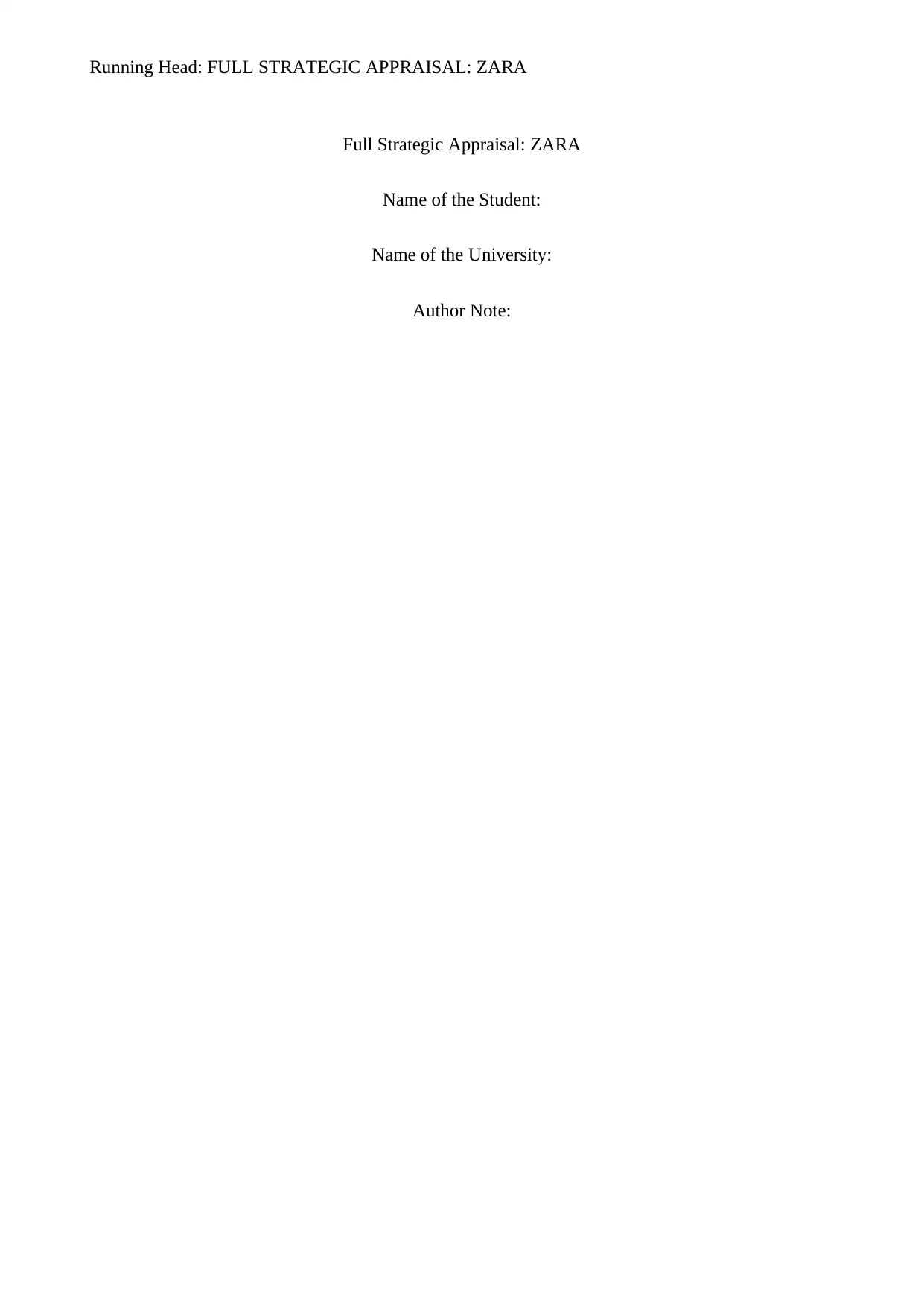
Running Head: FULL STRATEGIC APPRAISAL: ZARA
Full Strategic Appraisal: ZARA
Name of the Student:
Name of the University:
Author Note:
Full Strategic Appraisal: ZARA
Name of the Student:
Name of the University:
Author Note:
Paraphrase This Document
Need a fresh take? Get an instant paraphrase of this document with our AI Paraphraser
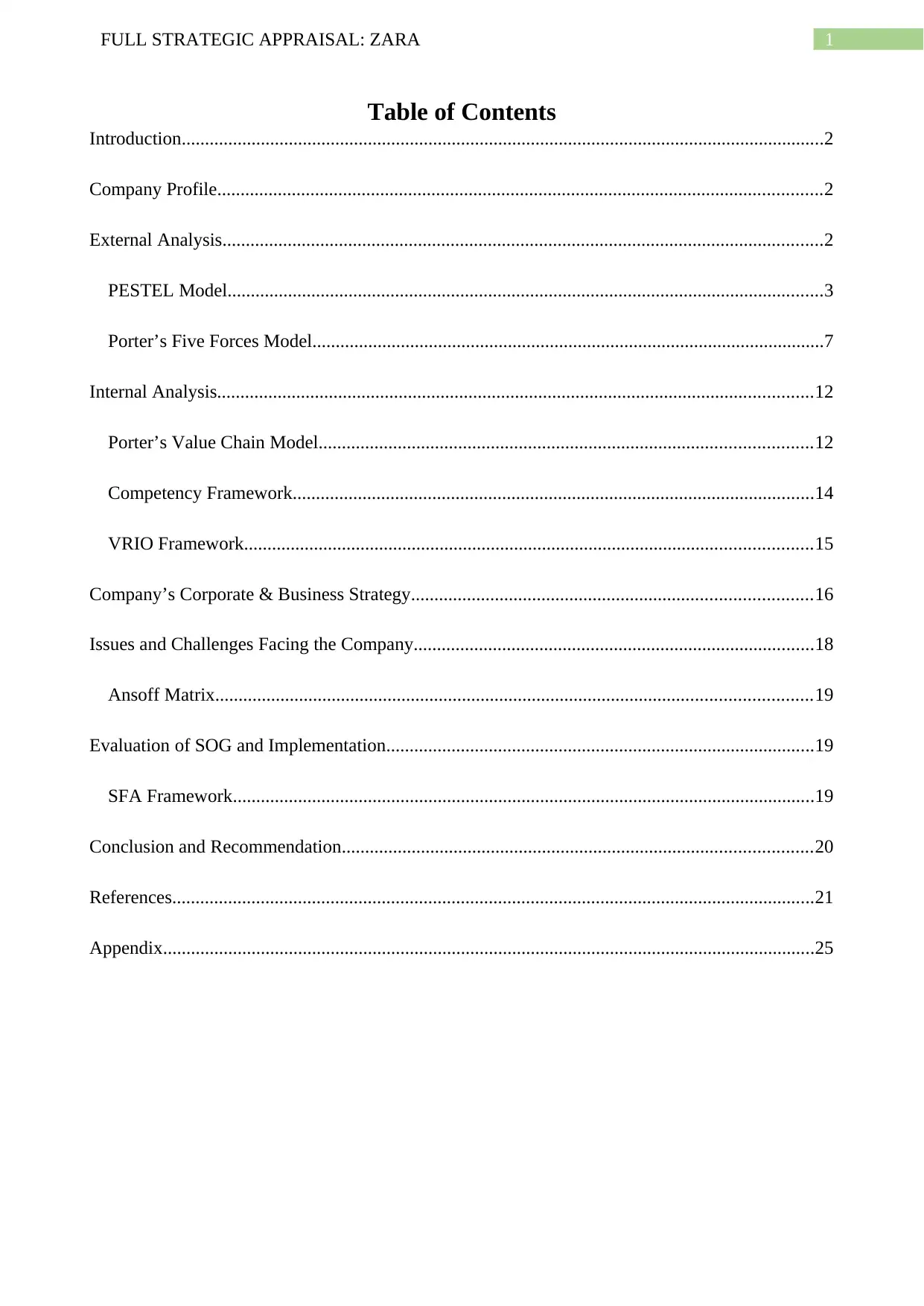
1FULL STRATEGIC APPRAISAL: ZARA
Table of Contents
Introduction..........................................................................................................................................2
Company Profile..................................................................................................................................2
External Analysis.................................................................................................................................2
PESTEL Model................................................................................................................................3
Porter’s Five Forces Model..............................................................................................................7
Internal Analysis................................................................................................................................12
Porter’s Value Chain Model..........................................................................................................12
Competency Framework................................................................................................................14
VRIO Framework..........................................................................................................................15
Company’s Corporate & Business Strategy......................................................................................16
Issues and Challenges Facing the Company......................................................................................18
Ansoff Matrix................................................................................................................................19
Evaluation of SOG and Implementation............................................................................................19
SFA Framework.............................................................................................................................19
Conclusion and Recommendation.....................................................................................................20
References..........................................................................................................................................21
Appendix............................................................................................................................................25
Table of Contents
Introduction..........................................................................................................................................2
Company Profile..................................................................................................................................2
External Analysis.................................................................................................................................2
PESTEL Model................................................................................................................................3
Porter’s Five Forces Model..............................................................................................................7
Internal Analysis................................................................................................................................12
Porter’s Value Chain Model..........................................................................................................12
Competency Framework................................................................................................................14
VRIO Framework..........................................................................................................................15
Company’s Corporate & Business Strategy......................................................................................16
Issues and Challenges Facing the Company......................................................................................18
Ansoff Matrix................................................................................................................................19
Evaluation of SOG and Implementation............................................................................................19
SFA Framework.............................................................................................................................19
Conclusion and Recommendation.....................................................................................................20
References..........................................................................................................................................21
Appendix............................................................................................................................................25
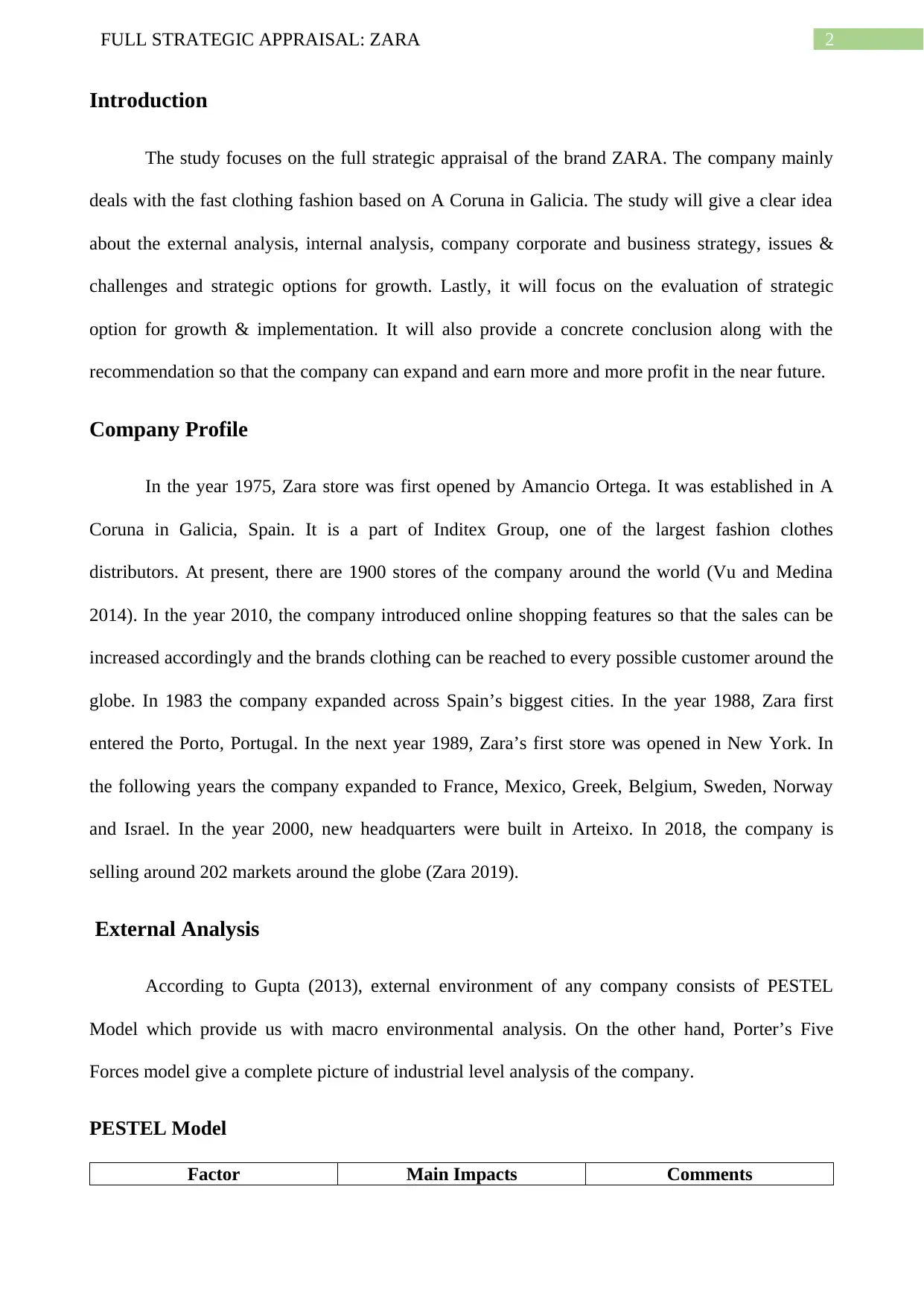
2FULL STRATEGIC APPRAISAL: ZARA
Introduction
The study focuses on the full strategic appraisal of the brand ZARA. The company mainly
deals with the fast clothing fashion based on A Coruna in Galicia. The study will give a clear idea
about the external analysis, internal analysis, company corporate and business strategy, issues &
challenges and strategic options for growth. Lastly, it will focus on the evaluation of strategic
option for growth & implementation. It will also provide a concrete conclusion along with the
recommendation so that the company can expand and earn more and more profit in the near future.
Company Profile
In the year 1975, Zara store was first opened by Amancio Ortega. It was established in A
Coruna in Galicia, Spain. It is a part of Inditex Group, one of the largest fashion clothes
distributors. At present, there are 1900 stores of the company around the world (Vu and Medina
2014). In the year 2010, the company introduced online shopping features so that the sales can be
increased accordingly and the brands clothing can be reached to every possible customer around the
globe. In 1983 the company expanded across Spain’s biggest cities. In the year 1988, Zara first
entered the Porto, Portugal. In the next year 1989, Zara’s first store was opened in New York. In
the following years the company expanded to France, Mexico, Greek, Belgium, Sweden, Norway
and Israel. In the year 2000, new headquarters were built in Arteixo. In 2018, the company is
selling around 202 markets around the globe (Zara 2019).
External Analysis
According to Gupta (2013), external environment of any company consists of PESTEL
Model which provide us with macro environmental analysis. On the other hand, Porter’s Five
Forces model give a complete picture of industrial level analysis of the company.
PESTEL Model
Factor Main Impacts Comments
Introduction
The study focuses on the full strategic appraisal of the brand ZARA. The company mainly
deals with the fast clothing fashion based on A Coruna in Galicia. The study will give a clear idea
about the external analysis, internal analysis, company corporate and business strategy, issues &
challenges and strategic options for growth. Lastly, it will focus on the evaluation of strategic
option for growth & implementation. It will also provide a concrete conclusion along with the
recommendation so that the company can expand and earn more and more profit in the near future.
Company Profile
In the year 1975, Zara store was first opened by Amancio Ortega. It was established in A
Coruna in Galicia, Spain. It is a part of Inditex Group, one of the largest fashion clothes
distributors. At present, there are 1900 stores of the company around the world (Vu and Medina
2014). In the year 2010, the company introduced online shopping features so that the sales can be
increased accordingly and the brands clothing can be reached to every possible customer around the
globe. In 1983 the company expanded across Spain’s biggest cities. In the year 1988, Zara first
entered the Porto, Portugal. In the next year 1989, Zara’s first store was opened in New York. In
the following years the company expanded to France, Mexico, Greek, Belgium, Sweden, Norway
and Israel. In the year 2000, new headquarters were built in Arteixo. In 2018, the company is
selling around 202 markets around the globe (Zara 2019).
External Analysis
According to Gupta (2013), external environment of any company consists of PESTEL
Model which provide us with macro environmental analysis. On the other hand, Porter’s Five
Forces model give a complete picture of industrial level analysis of the company.
PESTEL Model
Factor Main Impacts Comments
⊘ This is a preview!⊘
Do you want full access?
Subscribe today to unlock all pages.

Trusted by 1+ million students worldwide
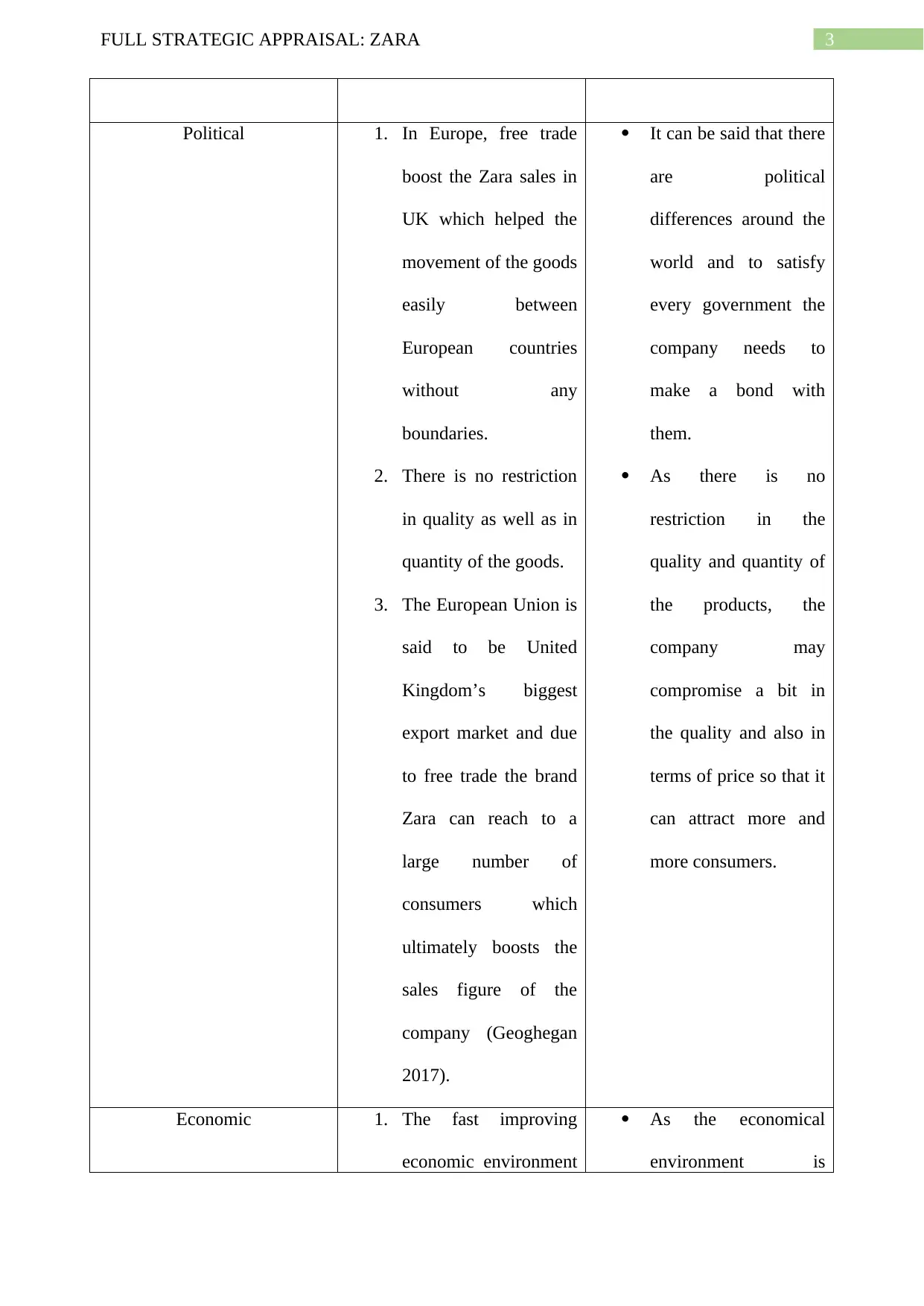
3FULL STRATEGIC APPRAISAL: ZARA
Political 1. In Europe, free trade
boost the Zara sales in
UK which helped the
movement of the goods
easily between
European countries
without any
boundaries.
2. There is no restriction
in quality as well as in
quantity of the goods.
3. The European Union is
said to be United
Kingdom’s biggest
export market and due
to free trade the brand
Zara can reach to a
large number of
consumers which
ultimately boosts the
sales figure of the
company (Geoghegan
2017).
It can be said that there
are political
differences around the
world and to satisfy
every government the
company needs to
make a bond with
them.
As there is no
restriction in the
quality and quantity of
the products, the
company may
compromise a bit in
the quality and also in
terms of price so that it
can attract more and
more consumers.
Economic 1. The fast improving
economic environment
As the economical
environment is
Political 1. In Europe, free trade
boost the Zara sales in
UK which helped the
movement of the goods
easily between
European countries
without any
boundaries.
2. There is no restriction
in quality as well as in
quantity of the goods.
3. The European Union is
said to be United
Kingdom’s biggest
export market and due
to free trade the brand
Zara can reach to a
large number of
consumers which
ultimately boosts the
sales figure of the
company (Geoghegan
2017).
It can be said that there
are political
differences around the
world and to satisfy
every government the
company needs to
make a bond with
them.
As there is no
restriction in the
quality and quantity of
the products, the
company may
compromise a bit in
the quality and also in
terms of price so that it
can attract more and
more consumers.
Economic 1. The fast improving
economic environment
As the economical
environment is
Paraphrase This Document
Need a fresh take? Get an instant paraphrase of this document with our AI Paraphraser
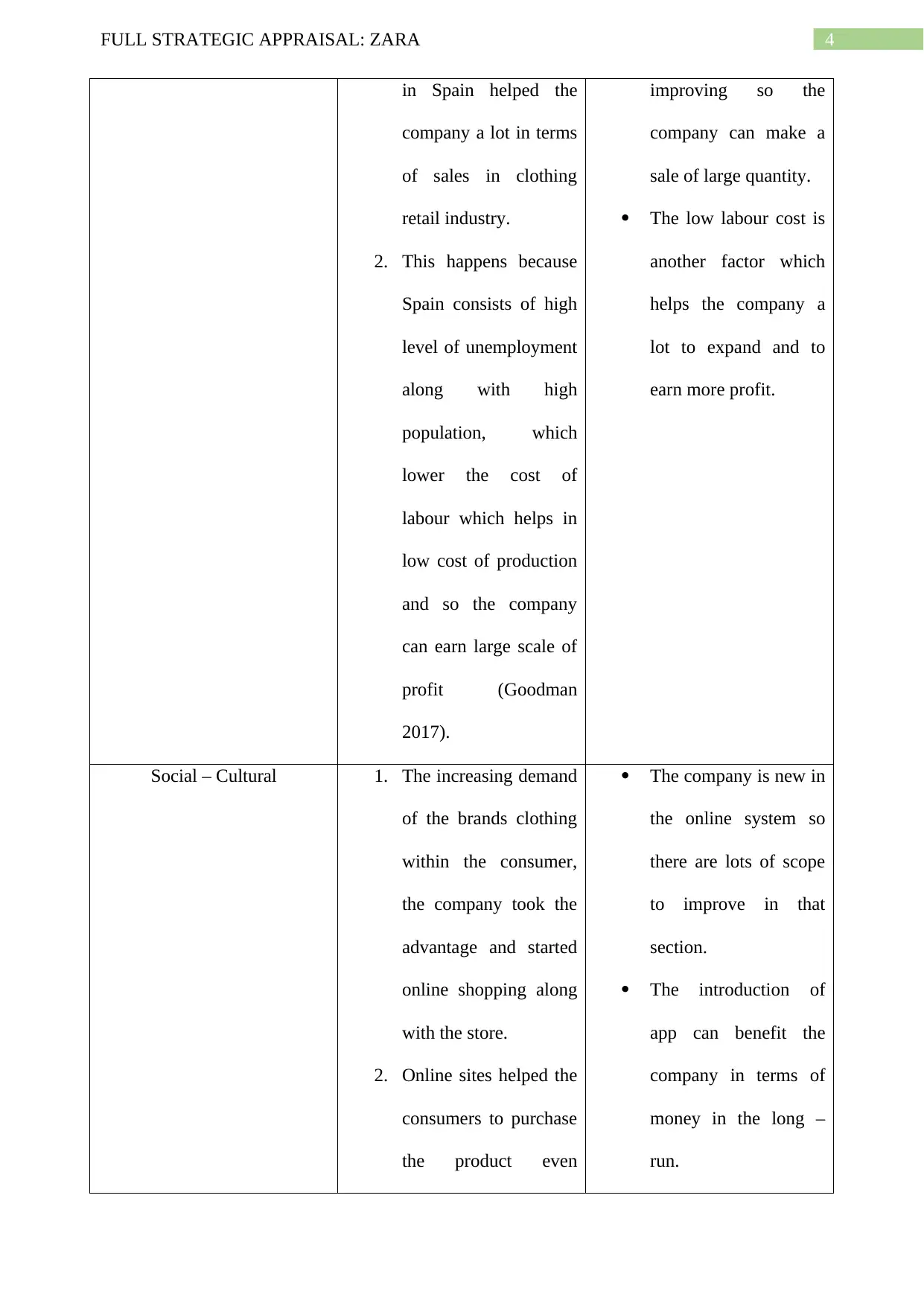
4FULL STRATEGIC APPRAISAL: ZARA
in Spain helped the
company a lot in terms
of sales in clothing
retail industry.
2. This happens because
Spain consists of high
level of unemployment
along with high
population, which
lower the cost of
labour which helps in
low cost of production
and so the company
can earn large scale of
profit (Goodman
2017).
improving so the
company can make a
sale of large quantity.
The low labour cost is
another factor which
helps the company a
lot to expand and to
earn more profit.
Social – Cultural 1. The increasing demand
of the brands clothing
within the consumer,
the company took the
advantage and started
online shopping along
with the store.
2. Online sites helped the
consumers to purchase
the product even
The company is new in
the online system so
there are lots of scope
to improve in that
section.
The introduction of
app can benefit the
company in terms of
money in the long –
run.
in Spain helped the
company a lot in terms
of sales in clothing
retail industry.
2. This happens because
Spain consists of high
level of unemployment
along with high
population, which
lower the cost of
labour which helps in
low cost of production
and so the company
can earn large scale of
profit (Goodman
2017).
improving so the
company can make a
sale of large quantity.
The low labour cost is
another factor which
helps the company a
lot to expand and to
earn more profit.
Social – Cultural 1. The increasing demand
of the brands clothing
within the consumer,
the company took the
advantage and started
online shopping along
with the store.
2. Online sites helped the
consumers to purchase
the product even
The company is new in
the online system so
there are lots of scope
to improve in that
section.
The introduction of
app can benefit the
company in terms of
money in the long –
run.
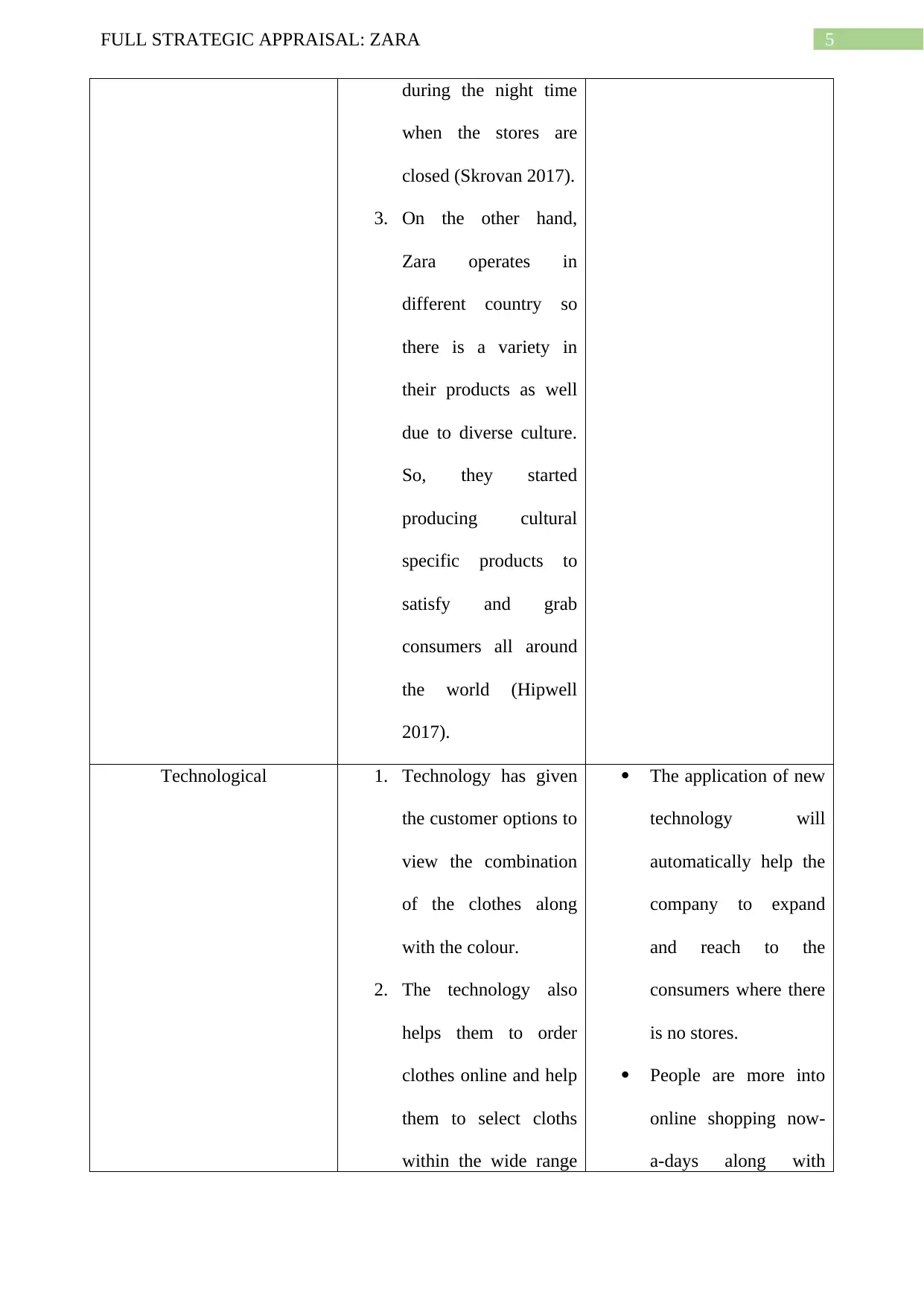
5FULL STRATEGIC APPRAISAL: ZARA
during the night time
when the stores are
closed (Skrovan 2017).
3. On the other hand,
Zara operates in
different country so
there is a variety in
their products as well
due to diverse culture.
So, they started
producing cultural
specific products to
satisfy and grab
consumers all around
the world (Hipwell
2017).
Technological 1. Technology has given
the customer options to
view the combination
of the clothes along
with the colour.
2. The technology also
helps them to order
clothes online and help
them to select cloths
within the wide range
The application of new
technology will
automatically help the
company to expand
and reach to the
consumers where there
is no stores.
People are more into
online shopping now-
a-days along with
during the night time
when the stores are
closed (Skrovan 2017).
3. On the other hand,
Zara operates in
different country so
there is a variety in
their products as well
due to diverse culture.
So, they started
producing cultural
specific products to
satisfy and grab
consumers all around
the world (Hipwell
2017).
Technological 1. Technology has given
the customer options to
view the combination
of the clothes along
with the colour.
2. The technology also
helps them to order
clothes online and help
them to select cloths
within the wide range
The application of new
technology will
automatically help the
company to expand
and reach to the
consumers where there
is no stores.
People are more into
online shopping now-
a-days along with
⊘ This is a preview!⊘
Do you want full access?
Subscribe today to unlock all pages.

Trusted by 1+ million students worldwide
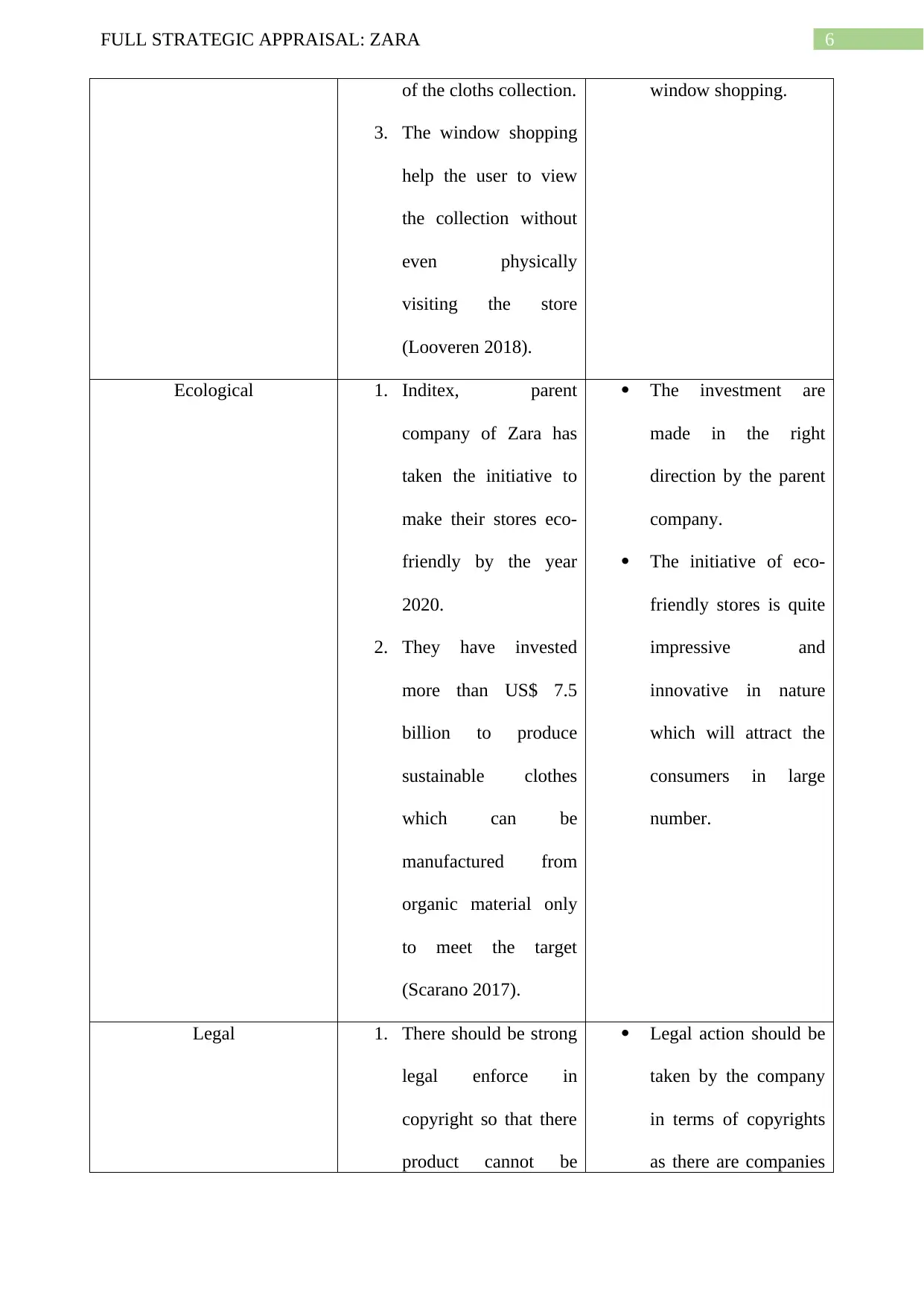
6FULL STRATEGIC APPRAISAL: ZARA
of the cloths collection.
3. The window shopping
help the user to view
the collection without
even physically
visiting the store
(Looveren 2018).
window shopping.
Ecological 1. Inditex, parent
company of Zara has
taken the initiative to
make their stores eco-
friendly by the year
2020.
2. They have invested
more than US$ 7.5
billion to produce
sustainable clothes
which can be
manufactured from
organic material only
to meet the target
(Scarano 2017).
The investment are
made in the right
direction by the parent
company.
The initiative of eco-
friendly stores is quite
impressive and
innovative in nature
which will attract the
consumers in large
number.
Legal 1. There should be strong
legal enforce in
copyright so that there
product cannot be
Legal action should be
taken by the company
in terms of copyrights
as there are companies
of the cloths collection.
3. The window shopping
help the user to view
the collection without
even physically
visiting the store
(Looveren 2018).
window shopping.
Ecological 1. Inditex, parent
company of Zara has
taken the initiative to
make their stores eco-
friendly by the year
2020.
2. They have invested
more than US$ 7.5
billion to produce
sustainable clothes
which can be
manufactured from
organic material only
to meet the target
(Scarano 2017).
The investment are
made in the right
direction by the parent
company.
The initiative of eco-
friendly stores is quite
impressive and
innovative in nature
which will attract the
consumers in large
number.
Legal 1. There should be strong
legal enforce in
copyright so that there
product cannot be
Legal action should be
taken by the company
in terms of copyrights
as there are companies
Paraphrase This Document
Need a fresh take? Get an instant paraphrase of this document with our AI Paraphraser
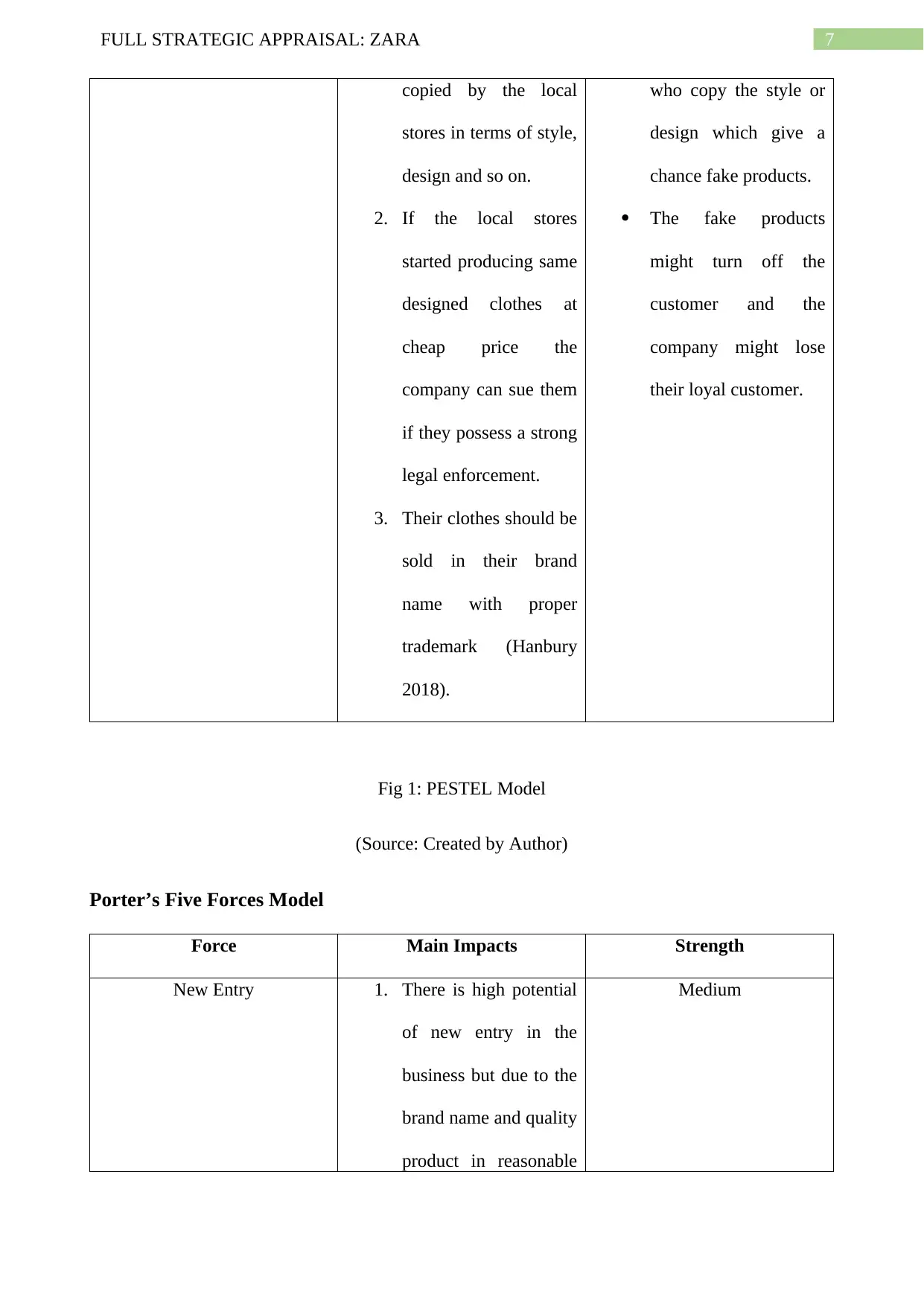
7FULL STRATEGIC APPRAISAL: ZARA
copied by the local
stores in terms of style,
design and so on.
2. If the local stores
started producing same
designed clothes at
cheap price the
company can sue them
if they possess a strong
legal enforcement.
3. Their clothes should be
sold in their brand
name with proper
trademark (Hanbury
2018).
who copy the style or
design which give a
chance fake products.
The fake products
might turn off the
customer and the
company might lose
their loyal customer.
Fig 1: PESTEL Model
(Source: Created by Author)
Porter’s Five Forces Model
Force Main Impacts Strength
New Entry 1. There is high potential
of new entry in the
business but due to the
brand name and quality
product in reasonable
Medium
copied by the local
stores in terms of style,
design and so on.
2. If the local stores
started producing same
designed clothes at
cheap price the
company can sue them
if they possess a strong
legal enforcement.
3. Their clothes should be
sold in their brand
name with proper
trademark (Hanbury
2018).
who copy the style or
design which give a
chance fake products.
The fake products
might turn off the
customer and the
company might lose
their loyal customer.
Fig 1: PESTEL Model
(Source: Created by Author)
Porter’s Five Forces Model
Force Main Impacts Strength
New Entry 1. There is high potential
of new entry in the
business but due to the
brand name and quality
product in reasonable
Medium
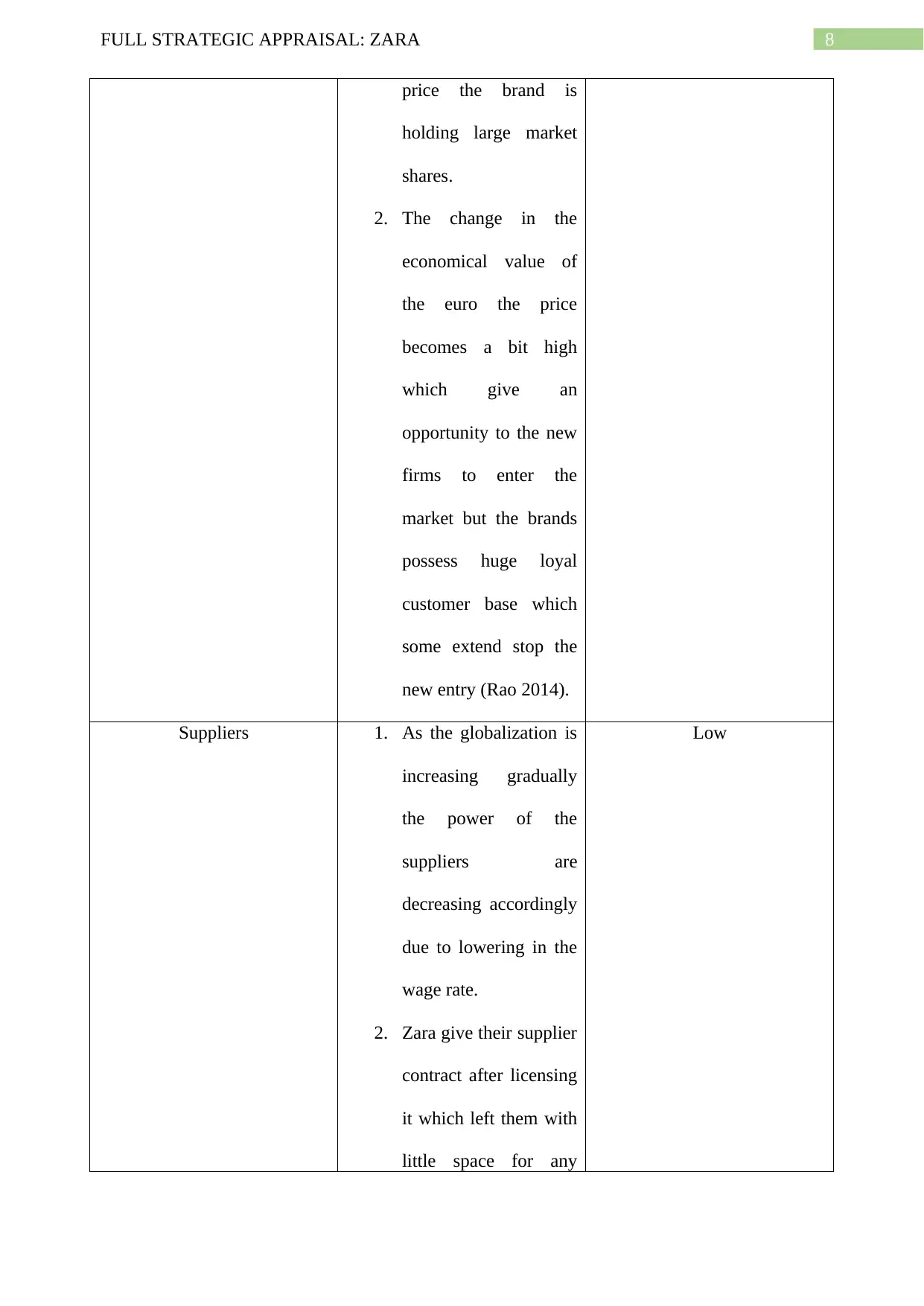
8FULL STRATEGIC APPRAISAL: ZARA
price the brand is
holding large market
shares.
2. The change in the
economical value of
the euro the price
becomes a bit high
which give an
opportunity to the new
firms to enter the
market but the brands
possess huge loyal
customer base which
some extend stop the
new entry (Rao 2014).
Suppliers 1. As the globalization is
increasing gradually
the power of the
suppliers are
decreasing accordingly
due to lowering in the
wage rate.
2. Zara give their supplier
contract after licensing
it which left them with
little space for any
Low
price the brand is
holding large market
shares.
2. The change in the
economical value of
the euro the price
becomes a bit high
which give an
opportunity to the new
firms to enter the
market but the brands
possess huge loyal
customer base which
some extend stop the
new entry (Rao 2014).
Suppliers 1. As the globalization is
increasing gradually
the power of the
suppliers are
decreasing accordingly
due to lowering in the
wage rate.
2. Zara give their supplier
contract after licensing
it which left them with
little space for any
Low
⊘ This is a preview!⊘
Do you want full access?
Subscribe today to unlock all pages.

Trusted by 1+ million students worldwide
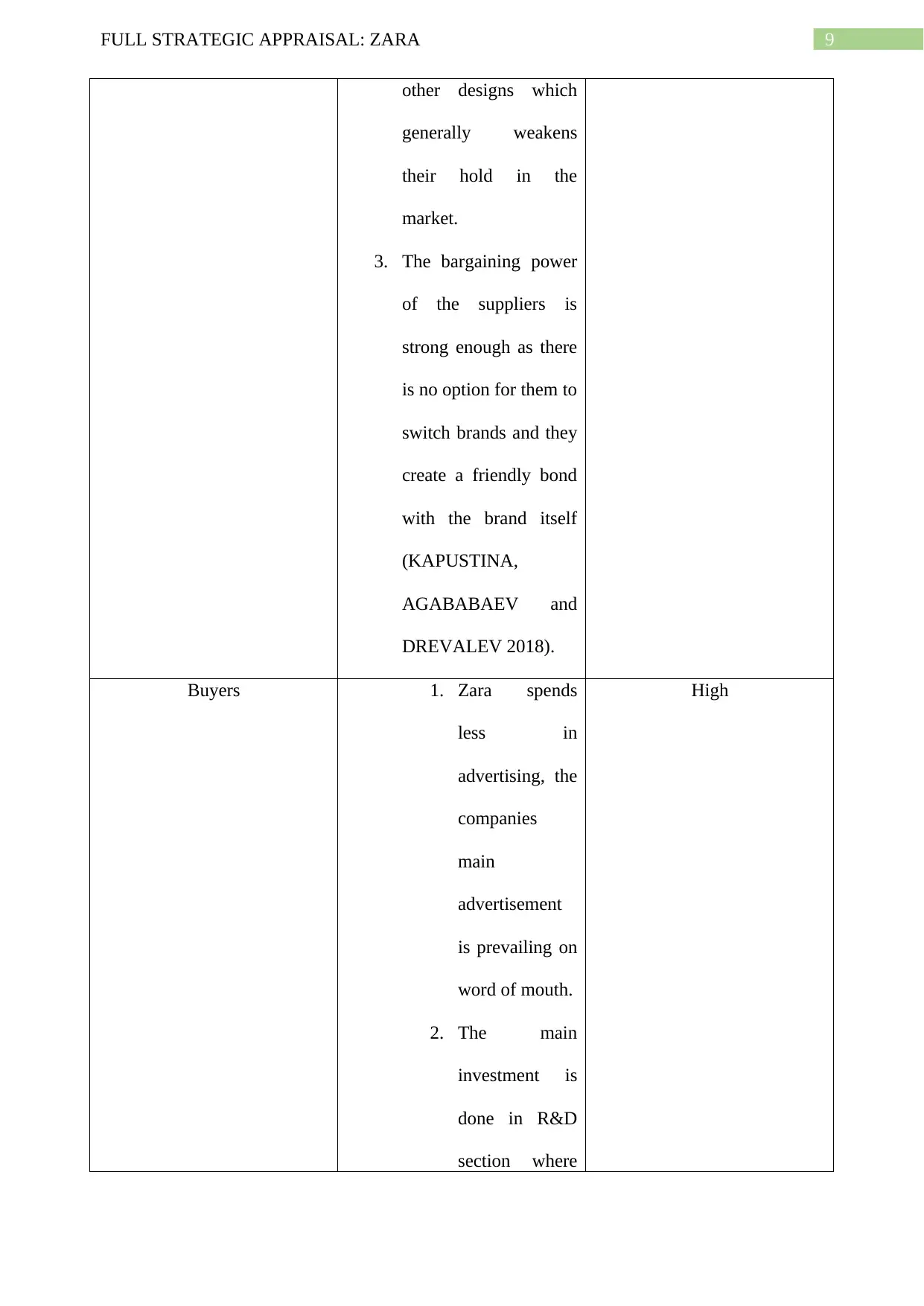
9FULL STRATEGIC APPRAISAL: ZARA
other designs which
generally weakens
their hold in the
market.
3. The bargaining power
of the suppliers is
strong enough as there
is no option for them to
switch brands and they
create a friendly bond
with the brand itself
(KAPUSTINA,
AGABABAEV and
DREVALEV 2018).
Buyers 1. Zara spends
less in
advertising, the
companies
main
advertisement
is prevailing on
word of mouth.
2. The main
investment is
done in R&D
section where
High
other designs which
generally weakens
their hold in the
market.
3. The bargaining power
of the suppliers is
strong enough as there
is no option for them to
switch brands and they
create a friendly bond
with the brand itself
(KAPUSTINA,
AGABABAEV and
DREVALEV 2018).
Buyers 1. Zara spends
less in
advertising, the
companies
main
advertisement
is prevailing on
word of mouth.
2. The main
investment is
done in R&D
section where
High
Paraphrase This Document
Need a fresh take? Get an instant paraphrase of this document with our AI Paraphraser
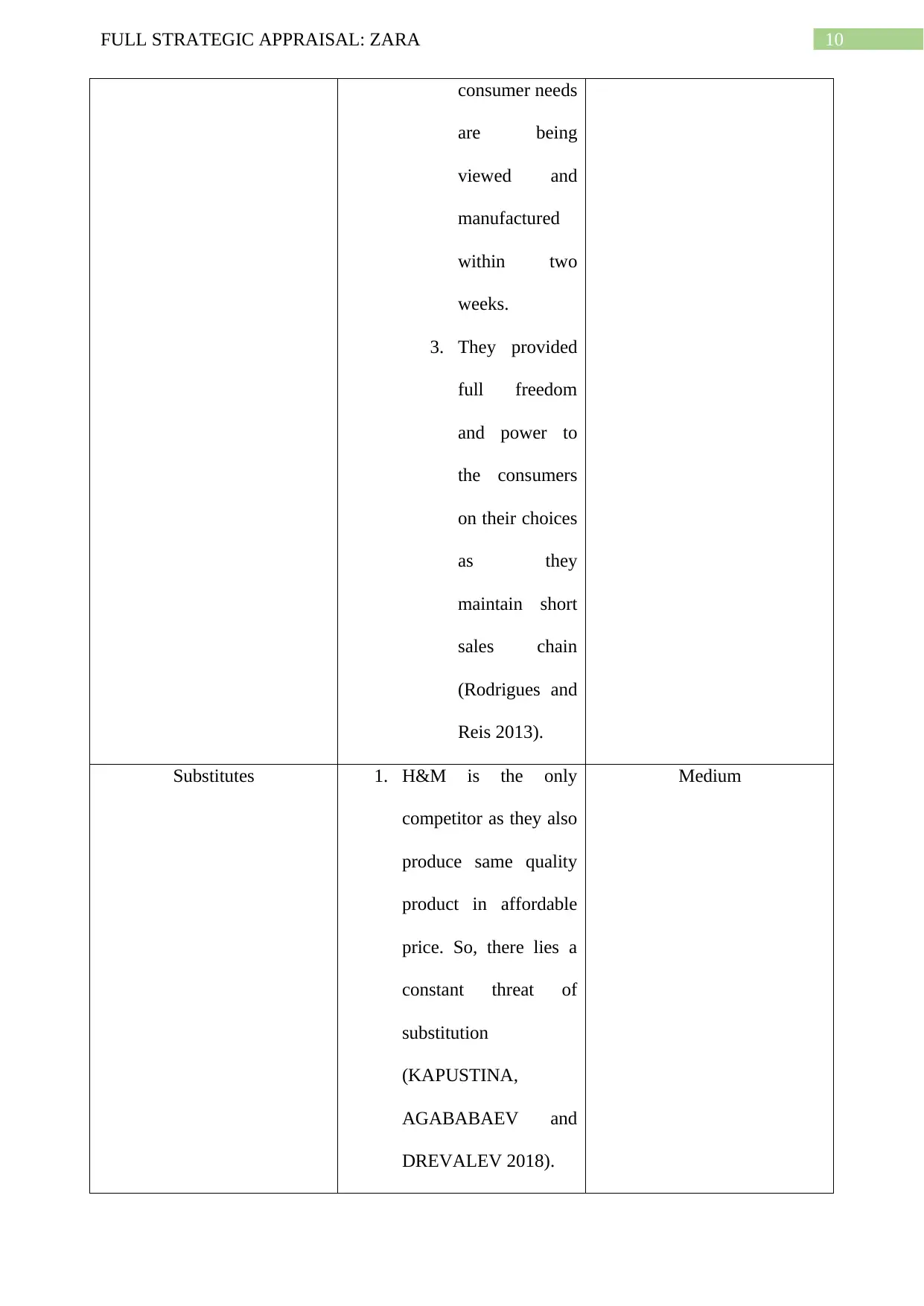
10FULL STRATEGIC APPRAISAL: ZARA
consumer needs
are being
viewed and
manufactured
within two
weeks.
3. They provided
full freedom
and power to
the consumers
on their choices
as they
maintain short
sales chain
(Rodrigues and
Reis 2013).
Substitutes 1. H&M is the only
competitor as they also
produce same quality
product in affordable
price. So, there lies a
constant threat of
substitution
(KAPUSTINA,
AGABABAEV and
DREVALEV 2018).
Medium
consumer needs
are being
viewed and
manufactured
within two
weeks.
3. They provided
full freedom
and power to
the consumers
on their choices
as they
maintain short
sales chain
(Rodrigues and
Reis 2013).
Substitutes 1. H&M is the only
competitor as they also
produce same quality
product in affordable
price. So, there lies a
constant threat of
substitution
(KAPUSTINA,
AGABABAEV and
DREVALEV 2018).
Medium
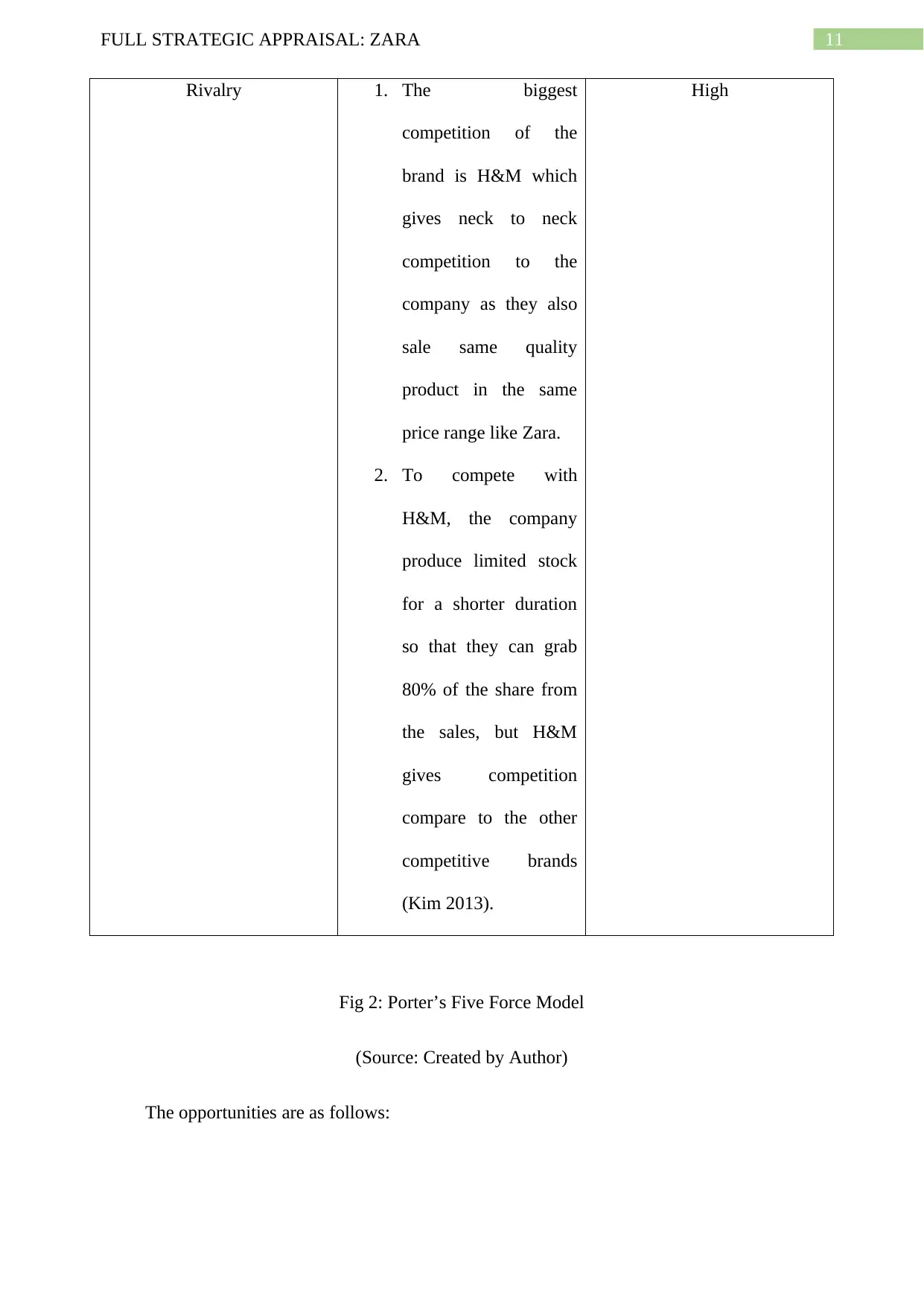
11FULL STRATEGIC APPRAISAL: ZARA
Rivalry 1. The biggest
competition of the
brand is H&M which
gives neck to neck
competition to the
company as they also
sale same quality
product in the same
price range like Zara.
2. To compete with
H&M, the company
produce limited stock
for a shorter duration
so that they can grab
80% of the share from
the sales, but H&M
gives competition
compare to the other
competitive brands
(Kim 2013).
High
Fig 2: Porter’s Five Force Model
(Source: Created by Author)
The opportunities are as follows:
Rivalry 1. The biggest
competition of the
brand is H&M which
gives neck to neck
competition to the
company as they also
sale same quality
product in the same
price range like Zara.
2. To compete with
H&M, the company
produce limited stock
for a shorter duration
so that they can grab
80% of the share from
the sales, but H&M
gives competition
compare to the other
competitive brands
(Kim 2013).
High
Fig 2: Porter’s Five Force Model
(Source: Created by Author)
The opportunities are as follows:
⊘ This is a preview!⊘
Do you want full access?
Subscribe today to unlock all pages.

Trusted by 1+ million students worldwide
1 out of 28
Related Documents
Your All-in-One AI-Powered Toolkit for Academic Success.
+13062052269
info@desklib.com
Available 24*7 on WhatsApp / Email
![[object Object]](/_next/static/media/star-bottom.7253800d.svg)
Unlock your academic potential
Copyright © 2020–2025 A2Z Services. All Rights Reserved. Developed and managed by ZUCOL.




